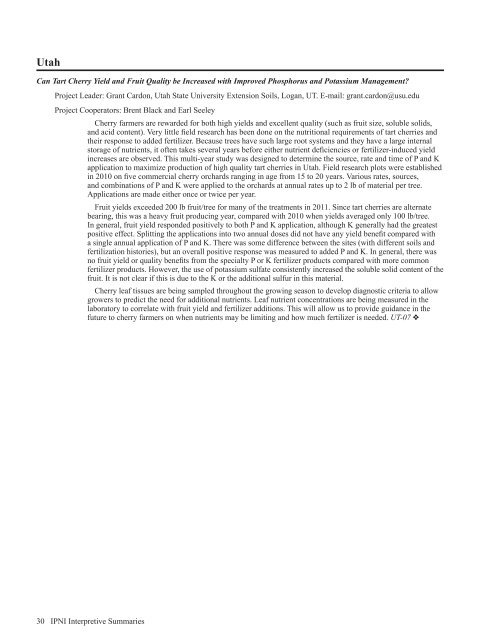Americas and Oceania Group - International Plant Nutrition Institute
Americas and Oceania Group - International Plant Nutrition Institute
Americas and Oceania Group - International Plant Nutrition Institute
Create successful ePaper yourself
Turn your PDF publications into a flip-book with our unique Google optimized e-Paper software.
Utah<br />
Can Tart Cherry Yield <strong>and</strong> Fruit Quality be Increased with Improved Phosphorus <strong>and</strong> Potassium Management?<br />
Project Leader: Grant Cardon, Utah State University Extension Soils, Logan, UT. E-mail: grant.cardon@usu.edu<br />
Project Cooperators: Brent Black <strong>and</strong> Earl Seeley<br />
Cherry farmers are rewarded for both high yields <strong>and</strong> excellent quality (such as fruit size, soluble solids,<br />
<strong>and</strong> acid content). Very little field research has been done on the nutritional requirements of tart cherries <strong>and</strong><br />
their response to added fertilizer. Because trees have such large root systems <strong>and</strong> they have a large internal<br />
storage of nutrients, it often takes several years before either nutrient deficiencies or fertilizer-induced yield<br />
increases are observed. This multi-year study was designed to determine the source, rate <strong>and</strong> time of P <strong>and</strong> K<br />
application to maximize production of high quality tart cherries in Utah. Field research plots were established<br />
in 2010 on five commercial cherry orchards ranging in age from 15 to 20 years. Various rates, sources,<br />
<strong>and</strong> combinations of P <strong>and</strong> K were applied to the orchards at annual rates up to 2 lb of material per tree.<br />
Applications are made either once or twice per year.<br />
Fruit yields exceeded 200 lb fruit/tree for many of the treatments in 2011. Since tart cherries are alternate<br />
bearing, this was a heavy fruit producing year, compared with 2010 when yields averaged only 100 lb/tree.<br />
In general, fruit yield responded positively to both P <strong>and</strong> K application, although K generally had the greatest<br />
positive effect. Splitting the applications into two annual doses did not have any yield benefit compared with<br />
a single annual application of P <strong>and</strong> K. There was some difference between the sites (with different soils <strong>and</strong><br />
fertilization histories), but an overall positive response was measured to added P <strong>and</strong> K. In general, there was<br />
no fruit yield or quality benefits from the specialty P or K fertilizer products compared with more common<br />
fertilizer products. However, the use of potassium sulfate consistently increased the soluble solid content of the<br />
fruit. It is not clear if this is due to the K or the additional sulfur in this material.<br />
Cherry leaf tissues are being sampled throughout the growing season to develop diagnostic criteria to allow<br />
growers to predict the need for additional nutrients. Leaf nutrient concentrations are being measured in the<br />
laboratory to correlate with fruit yield <strong>and</strong> fertilizer additions. This will allow us to provide guidance in the<br />
future to cherry farmers on when nutrients may be limiting <strong>and</strong> how much fertilizer is needed. UT-07 v<br />
30 IPNI Interpretive Summaries

















